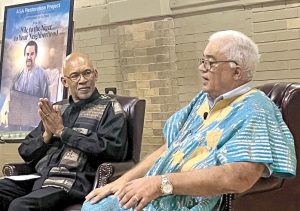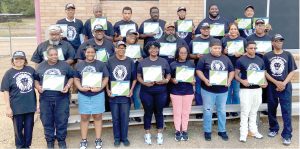Part I
After COVID-19 showed up in rural Noxubee County, Miss., in mid-March 2020, Shawanda Readus’ living room became a classroom. Noxubee County Schools closed the same month, so she brought desks in to accommodate her three children, but the single mom quickly realized that they cluttered her small Cedar Creek home in Macon, the county seat, so she removed them.
Readus was a server in the Noxubee County High School cafeteria when COVID-19 reached Mississippi. After the pandemic hit, she helped prepare and pack the meals that students could pick up to take the place of in-school lunches.
It was tough on Readus, as she was trying to earn a living at the school, even as it was closed for classes. The single mother spent hours on the phone with her children trying to ensure they were logged on at home. “It was hard because you are at work, and you have to call all day and check on them. They are calling you all day saying, ‘Mama, I don’t understand.’” Eventually, Readus’ mother had to step in and sit with the children, a 12-year-old daughter and 14-year-old twin sons, during the day. “It kinda took a toll on her because she is retired, but she had to sit here everyday to make sure that they did their work, like she was the teacher,” Readus said about her mother, Sadie King-Allen.
Readus only owned one laptop, and her mother brought over her tablet. That still left one child using a phone to log in to complete assignments. They used cell phones as hotspots.
“We tried to get internet, but where I live they kept saying I wasn’t eligible to get it,” Readus said later. Mostly rural Noxubee County is all the way over bordering Alabama in east central Mississippi. “They didn’t have the fast speed like I needed. They had something that would last like two or three days, and then it’s gone, which wouldn’t have done us any good.”
By July 2020, with her kids officially out of school for the summer, Readus contracted COVID-19 herself, but was not sure where she got it. She lost her appetite and was nauseous, fatigued and lethargic. She arrived at her doctor’s office to be tested and gave a blood sample to the nurse hidden behind PPE.
The Chosen to Care Medical Center in Columbus, Miss., didn’t have the nasal swabs then needed to test her for COVID-19, and the blood-test results would take more than a week to be processed. The recommended quarantine was difficult for the mother of three, but she returned home. Her symptoms were mild, so Readus simply ignored the recommendations and continued about her daily tasks.
Luckily, her children did not get sick.
The Noxubee County School District was one of only a few across the state that did not reopen in the fall to in-person learning for the 2020-2021 school year. Now, more than 20 months after COVID-19 hit Mississippi, districts like Noxubee in areas with dwindling resources are left trying to figure out how to move forward. Navigating the pandemic is especially difficult due to disparities that the coronavirus magnified for many families served by Mississippi’s public schools. In Noxubee County, 98% of the student body is Black in an area where 41.3% of the families live below the poverty threshold of $26,500 a year for a family of four.
A 2019 Institutions of Higher Learning’s University Research Center study found that 13.1% of Noxubee households, like Readus’, consisted of children under 18 with a female householder and no spouse present.
Local educators and administrators, many of them resilient Black women, are determined to make it work and find solutions that their students and families deserve. But that is a challenge now, just as it was before the pandemic hit, due to long-term disparities and historic and intentional inequities that made the effects of the pandemic especially acute for the Black women of Noxubee County and their families.
What Once Was: History of Inequity and Violence
Noxubee County is littered with the remains of what once was. A Saturday evening summer ride through downtown Shuqualak, this journalist’s hometown, reveals a proverbial ghost town. A concrete slab is all that is left of the Shuqualak Glove Factory, which at one time was one of the town’s most prolific employers. Crumbled brick lies beside an open space that once housed the Shuqualak Medical Clinic. Boarded businesses line one side of the main street. Abandoned train tracks frame the other. The 85% Black town no longer has a grocery story; the last one sits boarded up. The poverty rate was 37.5% as of 2020, and the population has steadily declined with an individual median income of $13,656 in 2019, before the pandemic hit.
The county seat, nine miles north of Shuqualak, has fared slightly better, at least visually. The main street of Macon still houses some of the same businesses that white families started there decades ago. Now run by the third, fourth or even fifth generation, they reflect the staunch familial ties that still abound in the county. Sprinkled between them are new businesses: a lawyer’s office, a clothing store, an event hall. A local white man owns the county’s only full grocery store, Tem’s Food Market, and Black families often complain that they have to drive up to Lowndes County for more reasonably priced groceries.
Even though Macon has a higher white population than Shuqualak at 14.8%, its poverty level was also higher at 36.7% in 2020.
Both population and jobs have steadily shrunk in the county and in Macon. Overgrowth surrounds an abandoned factory on Highway 45 South. Left neglected, it is a striking reminder that much of industry has left the county, taking jobs and livelihoods with them. Right outside town on Highway 14 West, scraps of bricks are all that are left of the once-thriving Boral Bricks, which closed in 2007. Outdoor Technologies followed the next year. They weren’t the only ones.
Noxubee County does still have a Confederate statue on its courthouse lawn, however. Within a month of George Floyd’s murder in Minnesota in May 2020, editor Scott Boyd of the Macon Beacon newspaper called for the statue to be moved to the masonic Odd Fellows cemetery. Last we saw, it was still on the northwest corner of the courthouse lawn across the street from the former jail, complete with gallows, that is now the public library.
Like a Delta County, But Not
Noxubee is like a Mississippi Delta county – but more than a hundred miles from the actual Delta. Today it consists of three small rural towns – county seat Macon; Shuqualak; and Brooksville – with other earlier towns now extinct. Names like Shuqualak are indigenous; the great Choctaw Chief Pushamataha was born about 1765 on Noxuba Creek near present-day Shuqualak. Noxubee is a Choctaw word meaning “stinking water.”
As a leader under pressure from a U.S. government bent on expansion and cheap property, Chief Pushamataha negotiated with the United States for compensation for continual theft of Choctaw lands, but after his sudden death during an 1824 lobbying trip to Washington, the white man’s pressure and subterfuge would win out. The Treaty of Dancing Rabbit Creek, signed Sept. 7, 1830, in a clearing in Mashulaville, cleared the way for the federal government to remove 90% of Mississippi’s Choctaws west on the Trail of Tears over time, amid broken promises to the Choctaw tribe. This allowed white wealth-building to race full-speed-ahead on the fertile lands at the southwestern tip of Appalachia, worked by enslaved African descendants.
At least two of the Choctaw signers of the Treaty of Dancing Rabbit Creek at Mashulaville in Noxubee County, Chiefs Greenwood Leflore and Mashulatubbee were among Choctaw leaders who enslaved African Americans. In the century following the treaty, Mashulaville was the site of rampant white-terrorist violence and attacks on free schools for Black and white students after the Civil War.
Today, .3% of Noxubee residents are Native American.
Today, the 10,284 Noxubee County residents are 72% Black with an average income of less than $34,000, an outgrowth of the county’s history as a wealthy outpost of plantations originally owned by wealthy planters mostly from the East Coast. Thousands of enslaved people worked the lands for planters, many with last names still prominent in the state today. Black people have outnumbered whites in Noxubee since its inception with 3,818 free people and 6,157 slaves in 1840, jumping to 5,171 free and 15,496 enslaved by 1860, 75 percent of the total.
The rich, stolen land made the area ripe for agricultural production for men like Major Thomas Garton Blewitt, the grandfather of Confederate Lt. Gen. Stephen D. Lee’s wife, Regina. After inheriting the 270-acre Devereaux plantation (also referred to as “York”), Lee tried to keep it profitable without free labor after losing the Civil War, even adding 500 acres to it.
But, as historian Herman M. Hattaway wrote in his 1969 thesis about Lee, then in his later biographies, Lee gave up, taking the wealth from slavery spoils to own large homes in nearby Columbus in Lowndes County. He later helped found the Mississippi A&M University (now called Mississippi State University) 35 miles from Macon in Starkville in 1878 for white men of all classes, not just the planter elites.
Education innovator Lee also helped lead efforts to censor racist goals of the Confederacy out of southern textbooks and helped write Jim Crow laws into the Mississippi Constitution in 1890 to stop Black voter participation, equal education opportunity and wealth-building.
Between the mid-1800s and early 1900s, Noxubee County ranked in the state’s top 10 producers of corn, oats, livestock, cotton, sweet potatoes and in the total value of its farms, and wealth for white settlers flourished then. It was also a destination for Black Americans looking for better lives after Emancipation making the county one of the state’s most populous then. Many Black tenant farmers gathered in Noxubee seeking steady income, but the population started its dramatic slide by the 20th century with limited living-wage opportunities and high cyclical poverty, especially among Black residents.
“Just like many of the Delta counties, (Noxubee) has lost a lot of its citizens Black and white because there are fewer jobs, and for skilled laborers there are few,” said Dr. Andrew Mullins Jr., now-retired assistant to the chancellor and associate professor of education at the University of Mississippi, who fondly recalls growing up on what is now Old Highway 45 in Noxubee County.
“Those who worked in agriculture for years didn’t get any training, just manual labor skills. Those jobs have decreased considerably. It’s just a dying area like so many counties in Mississippi that were totally dependent on agriculture.”
Mullins has deep family roots in Noxubee County. His great-great-great grandfather Joel Barnett was one of the earliest settlers of Noxubee County and a wealthy slave owner. He migrated there after Virginia and then Georgia looking for new land to farm. Barnett’s granddaughter married a Poindexter whose family owned the Ravine Plantation in northeast Noxubee County near the Alabama border. The family moved inside the Macon city limits in 1920. The house that Mullins’ grandfather built still sits across from the town’s only grocery store. His father ran a local hardware store for more than 50 years. The store, started by his grandparents, supplied local farmers both Black and white.
“Where you had a high population of slaves, you have a high population of African Americans today, but Noxubee County has one of the highest African American population percentages of any county east of I-55,” Mullins, this reporter’s former professor at the University of Mississippi, said in a phone interview.
“Where you had rural areas that were dependent on one crop and dependent on slave labor and then freedmen labor, you don’t have much education because of the poverty. High poverty and generational poverty generally yields low academic achievement.”
This in-depth Noxubee County historic report is part of the “(In)Equity and Resilience, Black Women, Systemic Barriers and COVID-19” project looking at systemic inequities long facing Mississippi’s Black women and their families and institutions that the pandemic revealed and exacerbated in Mississippi. In upcoming weeks and months, the BWC Project team is publishing what their systemic reporting and numerous solution circles with Black women revealed about three counties (so far): Noxubee (education); Hinds (violence and public safety) and Holmes (health care adequacy and access). The journalists are following up each county overview with specific solutions-journalisms pieces about problems their reporting revealed.
Visit the full BWC Project microsite at https://www.mississippifreepress.org/bwc/.
This project is a collaboration between the Mississippi Free Press and the Jackson Advocate with support from the Solutions Journalism Network.
Write solutions@mississippifreepress.org to offer feedback on the reporting or reach out to Kimberly Griffin at kimberly@mississippifreepress.org if you’d like to sponsor work in additional counties for this project.






